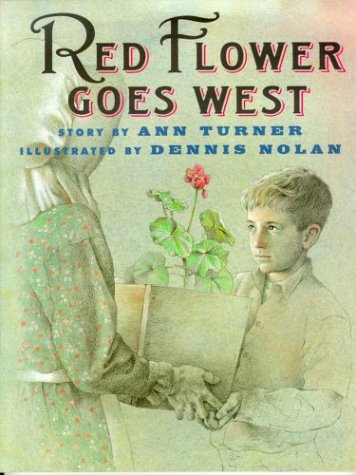
It’s a reckless journey, and the children must ease their minds with a red flower. It’s 1849, and the father has sold off the family’s farm so they can pursue gold and free land in California. Red Flower Goes West chronicles their long journey and all its hardships, plus the joys of a child’s perspective. The book’s jacket promises “a poignant portrayal…of this defining period in American history.”
The children are unenthusiastic about the journey – and so is their mother. (And on top of everything else, the oxen are ugly.) “Ma tightened her lips, dug a red flower from her garden, and set it in a wooden box,” announces the second page. The children’s mother insists that she won’t travel without the flower, which had come from her own mother’s garden. And when the family crosses the Missouri river on a ferry boat, daughter Jenny says the flower is “a traveler, like us.”
The drawings are simple and grey, though that may be to suggest the passage of time, or the difficulty of their trip. The child looks doubtfully at his mother as she hands him a box with the flower. Their ferry boat looks tiny on the enormous Missouri river. And the father nearly drowns when they can’t afford another ferry on an even swifter river.
When the father starts to drown in the river, his son clutched the Red Flower and “told her to watch over Pa.” (Just then an Indian dives into the water and rescues him.) “If that flower dies, we’ll never get to California,” the son says later, when they’re trapped in the barren drylands. But days later the flower grows a new leaf, and Jenny cheers that they’ll be saved. And at that moment, they spot green trees – and a river running between them.
There’s some American history behind the book – and the people who created it. Dennis Nolan, the illustrator, dedicates the book to a grandfather “who was born on the prairie on the way to California.” And the author dedicates the book to her father, “who has gone on his last great journey.” As the story ends, the nights are beginning to cool, and the family has reached the Sierra mountains. To help the oxen complete the crossing, the family themselves will walk along with the packs.
“California, here we are!” Pa cheers, and they settle in a peaceful green meadow. They plant the flower in the ground, and bring it water from a nearby stream. “We were like that red flower,” the boy decides, “dug up from our home soil, ferried over rivers, jolted over plains, drylands, and killer mountains.” For all its harsh history, the book finds a sweet metaphor.
“Red flower will grow new leaves and buds. And so will we, so will we.”